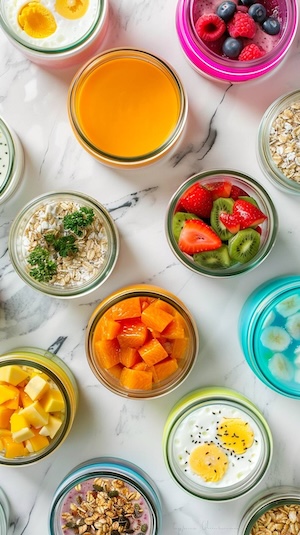PCOS for Picky Eaters: 30 Simple Meal Ideas
Discover 30 simple pcos meals for picky eaters that help manage symptoms. Easy pcos meals picky eaters will love, with practical tips and hormone-balancing ingredients.
This recipe includes superfoods such as:
Transform your health with tailored 7-day meal plans designed specifically for PCOS management. Just $7/month or $59/year.
Get it now →Dry ingredients:
1 cup almond flour (100 g / 3.5 oz)
¾ cup flaxmeal (ground flaxseed) (110 g / 4 oz)
¼ cup coconut flour (30 g / 1.1 oz)
2 tbsp whole psyllium husks (8 g / 0.3 oz)
2 tbsp chia seeds, ground (15 g / 0.5 oz)
1 tsp salt (I like pink Himalayan)
Wet ingredients:
1 cup water, lukewarm (240 ml / 8 fl oz) 2-4 tbsp if the dough is too dry
2 tbsp lard or extra virgin coconut oil or ghee (you can make your own) (30 g / 1.1 oz) - for greasing the pan
Optional seasonings:
1 tsp paprika ¼ tsp chili powder ( 0.1 g net carbs per serving) OR
½ tsp onion powder ½ tsp garlic powder ( 0.2 g net carbs per serving, my favourite!!!) OR
½ tsp curry powder ¼ tsp ground cumin ¼ tsp turmeric powder ( 0.1 g net carbs) OR
½ tsp dried oregano ½ tsp dried basil ½ tsp dried thyme ¼ tsp dried lemon zest or 1 tsp fresh lemon zest ( 0.1 g net carbs per serving) OR
¼ cup pesto (only use ¾ cup water). You can try my Red Pesto ( 0.3 g net carbs per serving) or green Paleo Avocado Pesto ( 0.6 g net carbs per serving)
Make sure you use kitchen scale for measuring all the dry ingredients. Using just cups may not be enough to achieve best results, especially in baked goods. Weights per cups and tablespoons may vary depending on the product/ brand or if you make you own ingredients (like flaxmeal from flaxseeds). You can make 10 regular tortillas (8 inch / 20 cm), or 5 large tortillas (12 inch / 30 cm). If you roll them out really thin, you can make up to 12 regular tortillas.
1. Place the flaxmeal, coconut flour, almond flour and psyllium husks into a bowl. For best results make sure you use whole psyllium husks. Using whole husks makes the tortillas more compact and flexible. This is different from my Ultimate Keto Buns where you need to use psyllium husk powder.
2. Add any of your favourite seasonings.
3. Add the ground chia seeds. To grind them, use a blender and pulse until powdered. I prefer using my Bamix immersion blender with the dry mill because it's easy to clean. Pour in the water and process until well combined using your hands. If needed, add a few tablespoons of water. However, if you use too much, the dough will get too sticky and difficult to roll. Let the dough rest in the fridge or on the kitchen counter for up to an hour.
4. Remove from the fridge and cut the dough into 6 equal pieces. You will use the cut-offs to make the remaining 4 tortillas. Place a piece of the dough between two pieces of baking paper and roll out until the dough is very thin. Alternatively, use a nonstick silicon covered roller and a silicon mat like I did.
5. Use a 20 cm / 8 inch lid or bowl to cut out the tortilla.
6. Repeat with the remaining dough and the cut-offs. If you have any dough left, use it for making nachos.
To make Tortillas:
Preheat a heavy-bottom pan greased with ~ 1 tsp ghee or lard. Place the tortilla on top of the hot pan and cook over a medium heat on each side for ~ 2 minutes until lightly browned. Don't overcook or the tortillas will become too crispy and will lose their flexibility. Grease more when needed and repeat for the rest of the tortillas. When done, leave them to cool down. To avoid the tortillas from getting too dry and hard, place in an airtight container and store for up to a week.
To make Tortilla Bowls:
Preheat the oven to 400 F / 200 C. Place the raw tortilla over a small heat-resistant bowl lined with baking paper and fold the edges round it to create a bowl shape. Lining the bowl is very important to prevent the dough from sticking. Place in the oven and bake for about 10 minutes until the top is lightly browned.
To make Taco Shells:
Cut small pieces of baking paper and place the tortillas on top. Place over a grid in the oven and turn the oven on. Make sure you make them wide enough so you can fit the filling. Cook until it reaches 400 F / 200 C and then cook for further 5-8 minutes or until crispy.
To make Tortilla chips / Nachos:
Roll out the dough and use a knife to cut triangular shaped nachos. Place on a pan greased with ghee or lard and cook on a medium heat for ~ 3 minutes on each side or until golden. Unlike tortillas, you should make the nachos crispy. You can also follow this recipe if you prefer to make them in the oven.

You know the drill: Alarm goes off. You hit snooze. Rush around frantically. Skip breakfast AGAIN because there's no time. By 10am, you're hangry, your blood sugar is all over the place, and your PCOS symptoms are already acting up.
Sound familiar?
Finally – a meal prep system designed specifically for women with PCOS who refuse to let chaotic mornings derail their health goals.
In just ONE hour on Sunday, you can transform your entire week:
"I went from skipping breakfast 4 days a week to having delicious, hormone-supporting meals ready every morning. My energy is more stable and my cravings have disappeared!"
– Sarah M.
Stop letting chaotic mornings control your health.
Get your hormone-happy mornings starting this Sunday.
→ Get Your 60-Minute Solution Now
Transform your health with tailored 7-day meal plans designed specifically for PCOS management. Just $7/month or $59/year.
Get it now →Serving Size: 10
| Amount Per ONE Serving | ||
|---|---|---|
| Calories 13 kcal | ||
| Fat 14 g | ||
| Carbohydrate 7.3 g | ||
| Protein 5.1 g | ||
💡 Introducing the 10/10 PCOS Solution:
Ten Delicious Crockpot Recipes that take just 10 minutes to prep!
Say goodbye to hours in the kitchen and hello to clean, PCOS-friendly meals made effortlessly.
👉 Click here to grab your 10/10 PCOS Solution today! Try The 10/10 PCOS Solution: Ten Crockpot Recipes That Take Just Ten Minutes to Prep
Managing PCOS can be challenging, but you don't have to do it alone. Join our supportive community to connect with others who understand what you're going through, share tips, and get encouragement. Here's how you can get involved:
Subscribe to our Newsletter: Receive PCOS-friendly recipes, tips, research updates, and more delivered straight to your inbox. Stay informed and empowered with the latest information and support.
Join our Telegram Channel: Stay updated with the latest tips and advice on managing PCOS.
Follow PCOS Meal Planner on Facebook: Engage with our community, participate in discussions, and get support from others.
Break the cycle with the PCOS Meal Planner - your personalized guide to eating better, feeling better, and managing PCOS symptoms. Take control today!

Forget the frustrating cycle of weight loss attempts, endless medications, and living in discomfort. Introducing the PCOS Meal Planner. A meal planning guide that goes beyond temporary fixes to offer a comprehensive strategy, empowering you to ignite a transformation towards lasting health and happiness. Step into a world where you control your PCOS, not the other way around.
Unlock Your PCOS Freedom Now.
Discover 30 simple pcos meals for picky eaters that help manage symptoms. Easy pcos meals picky eaters will love, with practical tips and hormone-balancing ingredients.
Discover 15 delicious overnight oats for PCOS recipes that help balance hormones and manage symptoms. Easy, nutritious breakfast ideas perfect for women with PCOS.
Discover the best cereal for PCOS with our expert rankings. Compare brands, check ingredients, and find PCOS friendly cereal that supports hormonal balance.
Learn how to transition away from fruit when starting a ketogenic diet for PCOS. Discover gradual strategies, fruit alternatives, and practical tips for success.
Discover 5 delicious PCOS banana bread recipes with low-glycemic ingredients. Learn how to make hormone-friendly banana bread that supports blood sugar balance.
Creatine for women with PCOS explained simply. Learn safety, benefits, hormone effects, tips, and how creatine may support PCOS symptoms naturally.
Complete PCOS diet plan with foods to eat, foods to avoid, meal timing, and real results. Learn the science-backed approach to managing PCOS through diet, with 7-day meal plan, grocery list, and step-by-step implementation guide. Based on clinical research and real patient outcomes.
Complete guide to ordering at Wendy's with PCOS. Discover the best protein-focused meals, what to skip, and how to customize orders to keep blood sugar stable. Learn which burgers, salads, and sides work for PCOS, plus complete macros for every menu item and smart swaps to avoid insulin spikes.
Complete guide to ordering at Burger King with PCOS. Discover the best protein-focused meals, what to skip, and how to customize orders to keep blood sugar stable. Learn which burgers, salads, and sides work for PCOS, plus complete macros for every menu item and smart swaps to avoid insulin spikes.